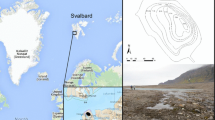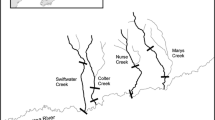Abstract
Arctic charr is the only freshwater fish in most of the High Arctic, with both resident, anadromous, and landlocked populations present. The anadromous Arctic charr is particularly highly sought-after, and has been an important food source for people living in Arctic regions. A recent decline in harvest in many areas has been related to over-exploitation by extensive gillnetting. Very few studies, if any, have estimated the gillnet efficiency for harvesting anadromous Arctic charr. In this study, all anadromous Arctic charr ascending the lake, Linnévatn, in western Spitsbergen, Svalbard, were marked over a period of 5 weeks, in July–August 2008. Recaptures in the lake were obtained by gillnetting with three mesh sizes (39, 45, and 52 mm measured knot-to-knot) during three periods. The total number of anadromous charr in the lake was estimated by both Schnabel and Petersen mark-recapture methods. The catchability increased significantly with fish size. Anadromous charr in the length-class 40.0–56.9 cm captured by the legal mesh size in Svalbard lakes (52 mm) had a mean catchability of 0.0023 per gillnet per 2 h fishing effort, and the catch quota which is set at 40 charr for Linnévatn by the Governor of Svalbard, would have been filled by less than five gillnets, each used for 6 h. Although this short fishing time may give an overestimation of catchability due to the avoidance of gear saturation, the high catchability values still indicate that anadromous Arctic charr populations may be extremely vulnerable to gillnetting. Hence, in addition to catch quotas set for each population, a restriction on the number of gillnets allowed per harvester should also be considered.




Similar content being viewed by others
References
Angelsen, K. K. & S. Olsen, 1987. Impact of fish density and effort level on catching efficiency of fishing gear. Fisheries Research 5: 271–278.
Anonymous, 2008. Regulations for harvesting of Arctic charr on Svalbard in 2009. Governor on Svalbard, Longyearbyen [available on internet at http://www.sysselmannen.no/enkel.aspx?m=44271&amid=2423191 (in Norwegian).
Balikci, A., 1980. Charr fishing among the Arviligjuarmiut. In Balon, E. K. (ed.), Charrs Salmonid Fishes of the Genus Salvelinus. Dr. W. Junk Publishers, The Hague, Netherlands: 7–11.
Borgstrøm, R., 1989. Direct estimation of gill-net selectivity for roach (Rutilus rutilus (L.)) in a small lake. Fisheries Research 7: 289–298.
Borgstrøm, R., 1992. Effect of population density on gillnet catchability in four populations of brown trout (Salmo trutta). Canadian Journal of Fisheries and Aquatic Sciences 49: 1539–1545.
Borgstrøm, R. & E. Plahte, 1992. Gillnet selectivity and a model for capture probabilities for a stunted brown trout (Salmo trutta) population. Canadian Journal of Fisheries and Aquatic Sciences 49: 1546–1554.
Borgstrøm, R. & T. Qvenild, 2000. Fishing gears—selectivity and test fishing. In Borgstrøm, R. & L. P. Hansen (eds), Fish in Freshwater. Landbruksforlaget, Oslo: 194–204 (in Norwegian).
Bøyum, A. & J. Kjensmo, 1978. Physiography of Lake Linnévatn, Western Spitsbergen. Verhandlungen der Internationale Vereinigung für Limnologie 20: 609–614.
Crecco, V. & W. J. Overholz, 1990. Causes of density-dependent catchability for Georges Bank haddock Melanogrammus aeglefinus. Canadian Journal of Fisheries and Aquatic Sciences 47: 385–394.
Crecco, V. A. & T. F. Savoy, 1985. Density-dependent catchability and its potential causes and consequences on Connecticut River American shad, Alosa sapidissima. Canadian Journal of Fisheries and Aquatic Sciences 42: 1649–1657.
Dempson, J. B., 1995. Trends in population characteristics of an exploited anadromous Arctic charr, Salvelinus alpinus, stock in northern Labrador. Nordic Journal of Freshwater Research 71: 197–216.
Dempson, J. B. & M. Shears, 1998. Characteristics of commercially exploited anadromous Arctic charr, Salvelinus alpinus, populations in northern Labrador with emphasis on the Voisy and Okak stock complexes. In Maitland, P. S. (ed.), Proceedings of the Seventh ISACF Workshop on Arctic Charr, 1992. Information Series 6, Institute of Freshwater Research, Drottningholm: 27–46.
Dempson, J. B., M. Shears, G. George & M. Bloom, 2008. Resilience and stability of north Labrador Arctic charr, Salvelinus alpinus, subject to exploitation and environmental variability. Environmental Biology of Fishes 82: 57–67.
Fukuwaka, M., T. Azumaya, N. D. Davis & T. Nagasawa, 2008. Bias in size composition of chum salmon (Oncorhynchus keta) caught by a gillnet with geometric series of mesh sizes, and its correction using gear intercalibration. ICES Journal of Marine Science 65: 930–936.
Gulseth, O. A., 2000. Seawater tolerance, migratory behaviour and growth of charr, Salvelinus alpinus, with emphasis on the high Arctic Dieset charr on Spitsbergen, Svalbard. Dr. philos. thesis, Department of Zoology, Norwegian University of Science and Technology, Trondheim.
Hamley, J. M., 1975. Review of gillnet selectivity. Journal of the Fisheries Research Board of Canada 32: 1943–1969.
Hamley, J. M. & H. A. Regier, 1973. Direct estimates of gillnet selectivity to walleye (Stizostedion vitreum vitreum). Journal of the Fisheries Research Board of Canada 30: 817–830.
Hammar, J., 1985. The geographical distribution of the Arctic char (Salvelinus alpinus (L.)) species complex in Svalbard. In Klemetsen, A., J. Hammar & L. Nyman (eds), Proceedings of the Third ISACF Workshop on Arctic Char, 1984. ISACF Information Series 3. Institute of Freshwater Research, Drottningholm: 29–37.
Hansen, M. J., R. G. Schorfhaar & J. H. Selgeby, 1998. Gill-net saturation by lake trout in Michigan waters of Lake Superior. North American Journal of Fisheries Management 18: 847–853.
Jensen, J. W., 1995. A direct estimate of gillnet selectivity for brown trout. Journal of Fish Biology 46: 857–861.
Johnson, L., 1980. The arctic charr, Salvelinus alpinus. In Balon, E. K. (ed.), Charrs. Salmonid fishes of the genus Salvelinus. Dr. W. Junk Publisher, The Hague, Netherlands: 15–98.
Johnson, L., 1994. Long-term experiments on the stability of two fish populations in previously unexploited Arctic lakes. Canadian Journal of Fisheries and Aquatic Sciences 51: 209–225.
Kristofferson, A. H., D. K. McGowan & G. W. Carder, 1984. Management of the commercial fishery for anadromous Arctic charr in the Cambridge Bay Area, Northwest Territories, Canada. In Johnson, L. & B. L. Burns (eds), Biology of the Arctic Charr. Proceedings of the International Symposium on Arctic Charr, Winnipeg, Manitoba, May 1981. University of Manitoba Press, Winnipeg: 447–461.
Lagler, K. F., 1968. Capture, sampling and examination of fishes. In Ricker, W. E. (ed.), Methods for Assessment of Fish Production in Fresh Waters. Blackwell, Oxford: 7–45.
MacCrimmon, H. R. & B. L. Gots, 1980. Fisheries for charrs. In Balon, E. K. (ed.), Charrs. Salmonid Fishes of the Genus Salvelinus. Dr. W. Junk Publisher, The Hague, Netherlands: 797–839.
Maitland, P. S., 1995. World status and conservation of the Arctic charr Salvelinus alpinus (L.). Nordic Journal of Freshwater Research 71: 113–127.
Nilssen, K. J., 2006. Arctic Charr on Svalbard: Biology, Management and Future. NTNU Bio kompetanse, Trondheim (in Norwegian).
Olin, M., M. Kurkilahti, P. Peitola & J. Ruuhijärvi, 2004. The effects of fish accumulation on the catchability of multimesh gillnets. Fisheries Research 68: 135–147.
Pinheiro, J. C. & D. M. Bates, 2000. Mixed-Effects Models in S and S-Plus. New York, Springer.
Ricker, W. E., 1975. Computation and interpretation of biological statistics of fish populations. Bulletin of Fisheries Research Board of Canada 191: 1–382.
Rikardsen, A. H., P.-A. Amundsen & P. J. Bodin, 2003. Growth and diet of anadromous Arctic charr after their return to freshwater. Ecology of Freshwater Fish 12: 74–80.
Rudstam, L. G., J. J. Magnuson & W. M. Tonn, 1984. Size selectivity of passive fishing gear: a correction for encounter probability applied to gillnets. Canadian Journal of Fisheries and Aquatic Sciences 41: 1252–1255.
Sømme, I. D., 1941. The Brown Trout Book. Jacob Dybwads forlag, Oslo (in Norwegian).
Svenning, M.-A., 1993. Life history variations and polymorphism in Arctic charr, Salvelinus alpinus (L.), on Svalbard and in northern Norway. Dr. scient. thesis. The Norwegian College of Fishery Science, University of Tromsø.
Svenning, M.-A.. & N. Gullestad, 2002. Adaptations to stochastic environmental variations: the effects of seasonal temperatures on the migratory window of Svalbard Arctic charr. Environmental Biology of Fishes 64: 165–174.
Svenning, M.-A., A. Klemetsen & T. Olsen, 2007. Habitat and food choice of Arctic charr in Linnévatn on Spitsbergen, Svalbard: the first year-round investigation in a High Arctic lake. Ecology of Freshwater Fish 16: 70–77.
Acknowledgments
We are indebted to the Governor of Svalbard for the transport of equipment and personnel, and to Longyearbyen’s hunting and fishing association for the loan of their cabin at Russekeila. Dr. Vladimir V. Sharin, and his staff are also thanked for their good food and help as well as the managers at Isfjord Radio, Eva and Håkon Nårstad, for their hospitality and help with logistics during the field sampling. A special thanks goes out to Øyvind Fredriksson for his invaluable field assistance. A sincere thanks to Nigel Yoccoz for help with the statistics, and to the associate editor and two anonymous referees for their comments and suggestions for improving the original manuscript.
Author information
Authors and Affiliations
Corresponding author
Additional information
Guest editors: C. Adams, E. Brännas, B. Dempson, R. Knudsen, I. McCarthy, M. Power, I. Winfield / Developments in the Biology, Ecology and Evolution of Charr
Rights and permissions
About this article
Cite this article
Borgstrøm, R., Ebne, I. & Svenning, MA. High lacustrine gillnet catchability of anadromous Arctic charr. Hydrobiologia 650, 203–212 (2010). https://doi.org/10.1007/s10750-010-0119-9
Received:
Accepted:
Published:
Issue Date:
DOI: https://doi.org/10.1007/s10750-010-0119-9




